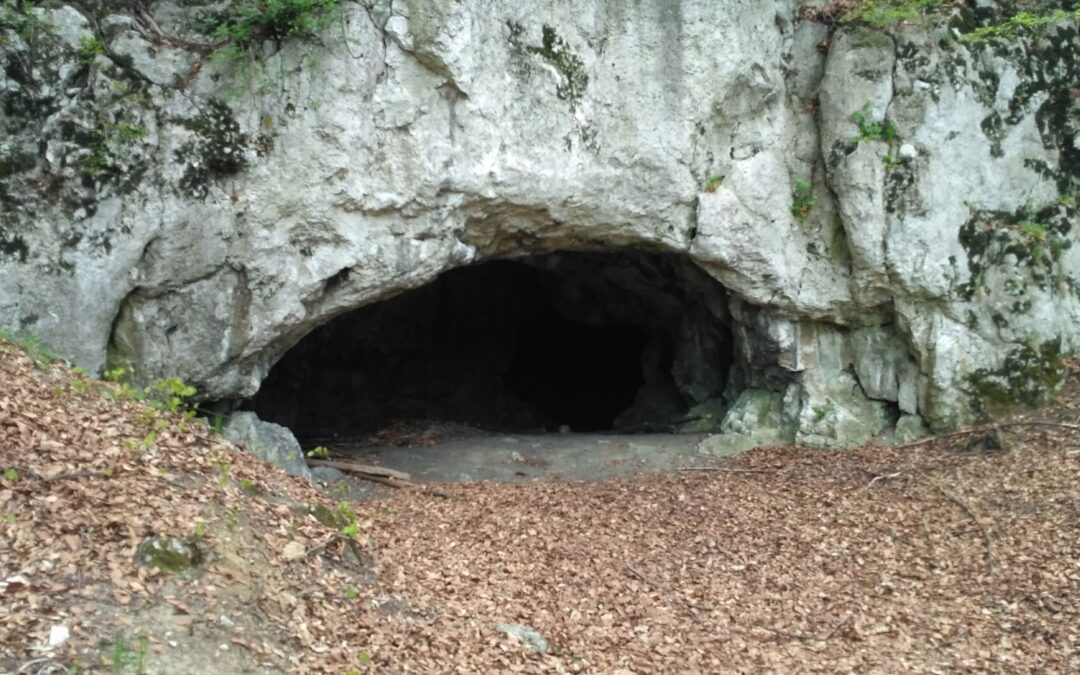Keep our news free from ads and paywalls by making a donation to support our work!

Notes from Poland is run by a small editorial team and is published by an independent, non-profit foundation that is funded through donations from our readers. We cannot do what we do without your support.
Analysis of prehistoric human bones discovered in a cave in Poland has confirmed that the people who inhabited it 18,000 years ago exhibited cannibalistic practices. Researchers believe the cannibalism was likely carried out for ritualistic reasons rather than being necessitated by hunger.
The new study, published in Nature, appears to put to an end a longstanding academic debate about the 63 bone fragments that were first discovered in the 19th century in the Maszycka cave (pictured above) in what is now Ojców National Park in southern Poland.
Studies of the remains, which belonged to Upper Paleolithic hunter-gatherers from the so-called Magdalenian cultures, conducted in the 1990s suggested that cannibalism had taken place, but that hypothesis was later challenged.
“The Maszycka cave is a very interesting but also very mysterious site,” Marta Połtowicz-Bobak, a Polish archaeologist who led the research, told the Polish Press Agency (PAP). “It is the remnant of an encampment of a group of people who arrived 18,000 years ago from western Europe.”
📢Excited to share our new paper on human cannibalism during the Magdalenian period! 🥩💀 Featuring new insights from Maszycka Cave (Poland). #Archaeology #Prehistory #Anthropology #Taphonomy @PalmiraSaladie @WhiteRabbit36 @iphes @IAM_CSIC
Available here: https://t.co/Jl5q2bUthQ— Cesc Marginedas (@Cesc_Marginedas) February 6, 2025
Researchers from the University of Rzeszów and the Rzeszów Archaeological Centre Foundation – both in Poland – as well as the Catalan Institute of Human Paleoecology and Social Evolution and the University of Göttingen used 3D scanning that allowed them to discover markings on the bones that went unnoticed in previous research.
“We have identified micro-scratches in places that show that attempts were made to separate muscles from the bones,” Dariusz Bobak from the Rzeszów Archaeological Centre Foundation told PAP.
“There are also traces of crushing, the breaking down of long bones to obtain bone marrow, which is a very calorific food,” he added. “Traces on the skull fragments indicate that an attempt was also made to access the brain, which is also very calorific.”
The researchers did not find any potential evidence that the human bones were processed to turn them into tools and other usable objects, further pointing to cannibalistic practices.
In their paper, the researchers highlighted that the manipulation of human corpses is a “well-documented behaviour among Magdalenian peoples” and can be understood as part of their “cultural repertoire of mortuary actions”.
PAP notes that many prehistoric cultures practiced cannibalism for ritual reasons, for example consuming the remains of loved ones to honour them or acquire their qualities. Meanwhile, the flesh of enemies was eaten in order to insult them even after death.
The findings from the Polish cave seem consistent with this interpretation as the researchers have previously found plentiful animal bones at the same site. “They had enough to eat, it seems cannibalism was not caused by hunger,” Połtowicz-Bobak told PAP.
The ritualistic practices of the Magdalenians in the Polish cave also seem to be confirmed by another finding, the skull of a saiga antelope discovered at the entrance.
The skull was covered in ochre, a red dye that “had a ritual significance in all primitive peoples, practically until modern times”, Bobak explained. “This suggests some kind of ritual associated with the site.”
A mammoth ivory pendant discovered in a cave in Poland is the oldest jewellery of its kind ever found on the Eurasian continent.
The item is around 41,500 years old, according to carbon dating https://t.co/HeWuX3Y7k1
— Notes from Poland 🇵🇱 (@notesfrompoland) December 3, 2021
The researchers note that the presence of the Magdalenian peoples in the Maszycka cave ended abruptly for unknown reasons. The site also contained an extensive collection of bone tools, which are rarely found in such quantities.
“Bone tools were valuable, they took much longer to make than flint tools, so no one just abandoned them unless they were damaged,” Bobak told PAP. “Here we have a whole collection.”
That “indicates that something violent happened” here, he added. “Either the sudden death of these people or they fled.”
200 large and well-preserved bear, cave lion and mammoth bones have been discovered during archaeological works in one of the most famous caves in Poland, called Paradise Cave.
The works there are being conducted for the first time since the 1960shttps://t.co/ZvjFeIv7ek
— Notes from Poland 🇵🇱 (@notesfrompoland) February 14, 2024

Notes from Poland is run by a small editorial team and published by an independent, non-profit foundation that is funded through donations from our readers. We cannot do what we do without your support.
Main image credit: Witold Mirek/Wikimedia Commons (under CC BY-SA 4.0)

Agata Pyka is an Assistant Editor at Notes from Poland. She specialises in Central and Eastern European affairs, cybersecurity, and investigative reporting. She holds a master’s degree in political communication from the University of Amsterdam, and her work has appeared in Euractiv, the Balkan Investigative Reporting Network (BIRN), and The European Correspondent, among others.



















